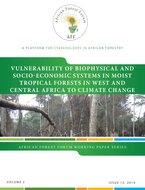Tropical forest of Africa represents 18% of the world total and covers over 3.6 million km2 in West, East and Central Africa. The bulk of tropical forests in Africa are found in West and Central Africa with the forests in Congo Basin of containing the largest remaining
contiguous expanse of moist tropical forests (MTFs) in Africa and the second largest in the world after the Amazon forest.
The West and Central African MTFs are characterized by annual rainfall of 1,400 – 4000 mm, and include moist deciduous and rain forests at low altitudes and Afromontane broadleaved forests at higher altitudes (> 900 m elevation). A large fraction of populations who live in rural areas depend on the MTFs for many of their subsistence and export of timber, and non-timber forest products generate income for countries in West and Central Africa.
The large expanse of MTFs in West and Central Africa holds much of Africas carbon, and the general vulnerability of the people and economies make the sub-regions important for consideration in terms of impacts from climate change. However, lack of accurate climate forecasting makes it difficult to accurately predict future conditions of climates in the subregions. But, there is still a need to consider the likely impacts of climate change on forests and the people who are dependent on forest products and services in order to put in place adaptive strategies for the people.
Climatic records show that the African continent is warmer than it was 100 years ago with warming of approximately 0.7 °C in most of the continent during the 20th Century, a decrease in rainfall over large portions of the Sahel and increase in rainfall in east-central
Africa. During this century, this warming trend and changes in precipitation patterns are expected to continue accompanied by a rise in sea level and increased frequency of extreme weather events.
The changes in temperature and rainfall will alter the environmental conditions to which trees in MTFs in Central and West Africa are adapted and expose them to new pests and diseases. The rich biodiversity, some of which concentrated in several centres of endemism of the MTFs, is at risk through extinction of species as a result of climate change.

